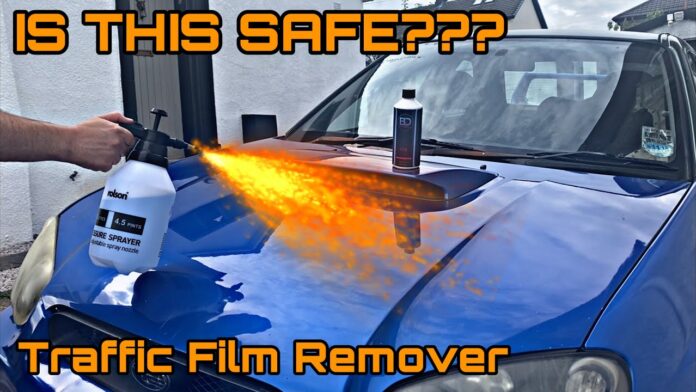Table of Contents
- Introduction
- What is a Traffic Film?
- The Role of Traffic Film Removers
- Key Chemicals in Traffic Film Removers
- Surfactants
- Solvents
- Chelating Agents
- pH Adjusters
- How Traffic Film Removers Work
- Safety and Environmental Considerations
- FAQs
- Conclusion
Traffic film removers (TFRs) are specialized cleaning agents designed to remove the stubborn grime that accumulates on vehicles. This grime, known as traffic film, is a combination of various pollutants and dirt particles. Understanding the chemical makeup of TFRs helps us appreciate how they effectively clean our vehicles. In this blog, we will look into the key components and their roles in TFRs.
What is a Traffic Film?
Traffic film is a layer of grime that forms on vehicles due to exposure to various pollutants, including:
- Road dust
- Exhaust emissions
- Oil and grease
- Salt and other deicing agents
- Organic matter
This combination makes traffic film particularly difficult to remove with standard cleaning agents.
What Are The Role of Traffic Film Removers?
Traffic film removers are formulated to break down and lift the stubborn grime from the vehicle’s surface, making it easier to wash away. They are more effective than regular detergents due to their specialized chemical composition.
What Are the Key Chemicals in Traffic Film Removers?
Surfactants
Surfactants are compounds that reduce surface tension, allowing the remover to spread more evenly and penetrate the grime. They are crucial for lifting dirt and oils from surfaces.
Types of Surfactants
- Anionic Surfactants: These are effective at removing oily dirt.
- Nonionic Surfactants: Known for their ability to clean organic matter.
Solvents
Solvents dissolve oils and greases, making them easier to remove. Common solvents in TFRs include:
- Isopropanol
- Butyl Glycol
- Ethanol
Chelating Agents
Chelating agents bind to metal ions, preventing them from interfering with the cleaning process. They help in removing mineral deposits and scaling.
Common Chelating Agents
- EDTA (Ethylenediaminetetraacetic Acid)
- NTA (Nitrilotriacetic Acid)
pH Adjusters
pH adjusters modify the acidity or alkalinity of the solution to enhance its cleaning effectiveness. Traffic film removers typically have a high pH to break down tough grime.
Common pH Adjusters
- Sodium Hydroxide
- Potassium Hydroxide
How Traffic Film Removers Work?
Traffic film removers work through a combination of chemical reactions:
- Penetration: Surfactants reduce surface tension, allowing the remover to penetrate the grime.
- Dissolution: Solvents dissolve oils and grease, breaking them down.
- Chelation: Chelating agents bind to metal ions, preventing interference.
- Alkaline Reaction: High pH helps to break down organic matter and other residues.
What Are the Safety and Environmental Considerations?
When using traffic film removers, it’s important to consider safety and environmental impacts:
- Safety Precautions: Always wear protective gear, such as gloves and eye protection.
- Environmental Impact: Choose biodegradable and environmentally friendly options when possible to reduce ecological harm.
FAQs
1. Are traffic film removers safe for all vehicle surfaces?
Most traffic film removers are safe for a variety of surfaces, but it’s always best to check the product label and test on a small area first.
2. Can I use a traffic film remover on a motorcycle?
Yes, but ensure the remover is suitable for the specific materials used on your motorcycle, such as plastics and metals.
3. How often should I use a traffic film remover?
It depends on your driving conditions. For vehicles exposed to heavy pollution, use a traffic film remover monthly. For less exposure, quarterly application may suffice.
4. Do traffic film removers damage wax or sealant on vehicles?
Some strong TFRs can strip wax or sealants. Look for pH-neutral formulas if you want to preserve protective coatings.
5. Are there eco-friendly traffic film removers available?
Yes, many manufacturers offer eco-friendly TFRs that are biodegradable and less harmful to the environment.
Conclusion
Understanding the chemical makeup of traffic film removers reveals the intricate blend of chemicals that work together to tackle tough grime and pollutants on vehicles.
Surfactants, solvents, chelating agents, and pH adjusters each play a vital role in breaking down and lifting away the stubborn layers of traffic film, ensuring your vehicle remains clean and well-maintained.
Choosing the right traffic film remover involves considering both its effectiveness and its environmental impact. Opt for products that balance powerful cleaning capabilities with eco-friendly formulations to protect both your vehicle and the environment.
Additionally, adhering to safety guidelines during use ensures that you can achieve optimal cleaning results without compromising your health or the well-being of your surroundings.




